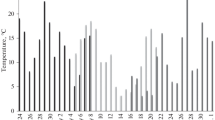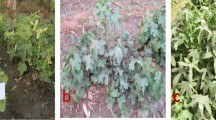Abstract
Most cultivars and hybrids of potato are sterile or have low fertility due to their complex interspecific origin. Information on the fertility of cultivars and hybrids used as initial parent forms is need to form and implement breeding programs. Searching for effective pollinators among cultivars and hybrids using traditional breeding tools in combination with marker-assisted selection is the purpose of the present study. In our study, the results of various types of intervarietal crosses carried out in 2008–2020 were analyzed. Among potato cultivars and hybrids, twenty-nine genotypes were identified as pollinators with a complex of agronomic traits, such as resistance to pathogens, suitability for processing, etc. These genotypes can be used as perspective parental forms for different directions of breeding work. Correlation analysis between the main indicators of fertility showed that the most reliable characteristics of pollinators are the number of formed berries and the number of seeds per pollinated flower. The index of fertility was calculated using these indicators. Genotypes identified among potato cultivars and hybrids as pollinators were separated by their fertility index into conditional groups. Two interspecific hybrids, 88.16/20 and 88.34/14, in the origin of which the autotetraploid S. garciae K2727 (VIR), which is resistant to potato virus Y was used, were selected among the most effective pollinators along with cultivars. Since male sterility in potatoes is associated with a specific type of cytoplasmic genome, information on the type of cytoplasm can been considered as one of the indicators of sterility/fertility of cultivars and hybrids. The genetic diversity of the cytoplasmic genome of 207 potato genotypes, including cultivars of Russian and foreign selection, backcross hybrids, and samples of species Solanum, was determined with specific molecular markers. Among the 207 studied samples of potato, 48% had T (T/β) type cytoplasm, 28% had the D-type cytoplasm, and 24% had the W (W/α, W/β, W/γ)-type cytoplasm. Among foreign varieties of potato and selected pollinators, T-type cytoplasm predominated, while the largest number of genotypes had D-type cytoplasm among the Russian cultivars of potato. The rare subtype cytoplasms W/α and W/β were found in interspecific hybrids and Solanum species and were absent in potato cultivars. The molecular marker YES3-3A of the Rysto gene was found not only in genotypes with the W/γ-type of the cytoplasmic genome.
Similar content being viewed by others
REFERENCES
Ross, H., Potato Breeding-Problems and Perspectives, Yashina, I.M., Ed., Moskow: Agropromizdat, 1989.
Sklyarova, N.P., Yashina, I.M., Svirkina, E.Kh., et al., Characteristics of some varieties of the world collection of potatoes by fertility, in Selektsiya i semenovodstvo kartofelya: nauchnye trudy (Selection and Seed Production of Potatoes: Scientific Papers), Moscow: Vseross. Nauchno-Issled. Inst. Kartofel’n. Khoz., 1975, pp. 53–61.
Slater, A.T., Cogan, N.O.I., Hayes, B.J., et al., Improving breeding efficiency in potato using molecular and quantitative genetics, Theor. Appl. Genet., 2014, vol. 127, pp. 2279–2292. https://doi.org/10.1007/s00122-014-2386-8
Ramakrishnan, A.P., Ritland, C.E., Blas Sevillano, R.H., et al., Review of potato molecular markers to enhance trait selection, Am. J. Potato Res., 2015, vol. 92, pp. 455–472. https://doi.org/10.1007/s12230-015-9455-7
Hosaka, K. and Sanetomo, R., Application of a PCR-based cytoplasm genotyping method for phylogenetic analysis in potato, Am. J. Potato Res., 2014, vol. 91, pp. 246–253. https://doi.org/10.1007/s12230-013-9344-x
Sanetomo, R. and Gebhardt, C., Cytoplasmic genome types of European potatoes and their effects on complex agronomic traits, BMC Plant Biol., 2015, vol. 15, art. ID 162. https://doi.org/10.1186/s12870-015-0545-y
Anisimova, I.N. and Gavrilenko, T.A., Cytoplasmic male sterility and prospects for its utilization in breeding, genetic studies and seed production of potato, Vavilovskii Zh. Genet. Sel., 2017, vol. 21, no. 1, pp. 83–95. https://doi.org/10.18699/VJ17.226
Mihovilovich, E., Sanetomo, R., Hosaka, K., et al., Cytoplasmic diversity in potato breeding: case study from the International Potato Center, Mol. Breed., 2015, vol. 35, art. ID 137. https://link.springer.com/article/10.1007%2Fs11032-015-0326-1. Cited March 7, 2021.
Zoteeva, N.M., Antonova, O.Yu., Klimenko, N.S., et al., Facilitation of introgressive hybridization of wild polyploidy mexican potato species using DNA markers of R genes and of different cytoplasmic types, S-kh. Biol., 2017, vol. 52, no. 5, pp. 964–975. https://doi.org/10.15389/agrobiology.2017.5.964rus
Gavrilenko, T.A., Klimenko, N.S., Alpat’eva, N.V., et al., Cytoplasmic genetic diversity of potato varieties bred in Russia and FSU countries, Vavilovskii Zh. Genet. Sel., 2019, vol. 23, no. 6, pp. 753–764. https://doi.org/10.18699/VJ19.534
Song, Y.-S. and Schwarzfischer, A., Development of STS markers for selection of extreme resistance (Ry sto) to PVY and maternal pedigree analysis of extremely resistant cultivars, Am. J. Potato Res., 2008, vol. 85, pp. 159–170. https://doi.org/10.1007/s12230-008-9012-8
Elison, G.L., Hall, D.G., Novy, R.G., et al., Development and application of a multiplex marker assay to detect PVY resistance genes in Solanum tuberosum, Am. J. Potato Res., 2020, vol. 97, pp. 289–296. doi.org/https://doi.org/10.1007/s12230-020-09777-1
Kasai, K., Morikawa, Y., Sorri, V.A., et al., Development of SCAR markers to the PVY resistance gene Ryadg based on a common feature of plant disease resistance genes, Genome, 2000, vol. 43, no.1, pp. 1–8. https://doi.org/10.1139/g99-092
Yermishin, A.P., Levy, A.V., Voronkova, E.V., et al., Overcoming unilateral incompatibility in crosses with wild allotetraploid potato species Solanum stoloniferum Schldtl. & Bouchet, Euphytica, 2017, vol. 213, no. 11, art. ID 249. https://link.springer.com/ article/10.1007%2Fs10681-017-2041-y. Cited March 6, 2021. https://doi.org/10.1007/s10681-017-2041-y
Author information
Authors and Affiliations
Corresponding authors
Ethics declarations
COMPLIANCE WITH ETHICAL STANDARDS
This article does not contain any studies involving animals or human participants performed by any of the authors.
CONFLICT OF INTEREST
The authors declare that they have no conflicts of interest.
Additional information
Translated by V. Mittova
About this article
Cite this article
Biryukova, V.A., Zharova, V.A., Mitushkin, A.V. et al. Characteristics of Varieties and Hybrids of Potato on Fertility. Russ. Agricult. Sci. 48, 162–168 (2022). https://doi.org/10.3103/S106836742203003X
Received:
Revised:
Accepted:
Published:
Issue Date:
DOI: https://doi.org/10.3103/S106836742203003X




